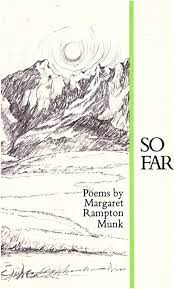Articles/Essays – Volume 21, No. 2
A Life Well-Shared | Margaret Rampton Munk, So Far: Poems
In the Fall of 1985 DIALOGUE published Meg Munk’s suite of poems entitled, “One Year.” In a mature voice and through particular images, she dramatized her battle with cancer. In the spring of 1986, this suite joined with others, some reprinted from DIALOGUE and Exponent II, to make her first book of poems. Its title—So Far—announced a poet and a life still in process for which poetry had been both therapy and record. “Contrary to the best advice and the best of intentions,” Meg explained in the forward, “I have never been a keeper of diaries or journals. I have found, however, that poetry has been a satisfactory way for me to give expression to feelings and the impact of events on my life.”
Two short months later, in the summer of 1986, Meg died. She spent some of her last moments preparing her funeral service and writing a letter to her friends to be read by her daughter. In the letter she asked that her friends refrain from attempting to comfort her children with the doc trine that she had been called to a better place. Her place, the place she had fought so hard to retain, was on this “sweet terrestrial” earth with her family and friends.
As one of several she had designated to read a poem or scripture at the service, I chose “Let There be Trees” (p. 54). As I sat in the chapel near the windows, I took courage from the trees outside the windows whose curtains were opened at Meg’s direction. The poem pleads for her view of the hereafter: “Tell me there are trees/ And all the sweet terrestrial things I love —/ And that I need not leave these joys/ To be with Thee” (p. 55).
Her love for the earth and all living things is organized in five parts that cover the emotional terrain of her life. The first deals with her family members, in poems sometimes named for them. When her adopted daughter cries for her “real mother,” she answers with a poem about the obscurity of Heavenly Mother: “I cannot tell her yet/ How I have cried/ Sometimes at night/ To one whose memory/ My birth erased/ . . . Then hid her face from me” (p. 7).
In “Kinship” (p. 13), a thoughtless “matriarch” asks her about her Filipino son: “Why graft this brown-skinned child/ Into your family tree,/ A tropic pineapple/ Upon a bough of temperate pears?/ . . . This is not your son.” To which the poet responds: “She has forgotten/ To be prouder still/ Forgotten that her family/ And mine,/ Is large,/ and ancient,/ And of royal lineage.” And then she concludes: “She is right/ That he is not my son/ He is my brother.” Thus she joins good Mormon doctrine with brotherhood in a special way.
In these poems, as well as in her fiction, essays, and family history, Meg took upon herself the sufferings of others. If that meant dressing a dead sister’s body for burial in her role as Relief Society president, she did that. If it meant writing openly about an attempted rape so that others might be warned and better informed, she did that. In the other sections of the book entitled “Sisterhood,” “Earth and Sky,” “Faith and Doubt,” and “One Year,” Meg eventually explores her own suffering. When I first read “One Year,” I marveled at her power to describe the ravages of cancer while she was still in the throes of it. Isn’t poetry supposed to be “emotion recollected in tranquility?” She describes all the stations of her cross with strong, sure strokes. Without sentimentality she applies her extraordinary perceptions to the rhythms of speech and the concrete details of ordinary life.
In “The News” she mentally rehearses a scene in which the tumor is pronounced “benign,” and then with a “hard tube filling up/ The passageway of sound,” she rewrites the scene to read “malignant” and turns the instruments of her torture into the language of poetry. When she tells her doctor that she cannot bear to undergo treatment, he assures her that she will change her mind—for the children. And then she recounts the chapters of chemotherapy with their cruel attack on the “copper strands” of her hair. The hair has become a symbol of her childhood, her young womanhood, and her marriage when she “grew it long again/ For him.” Finally, she combs it “clipped and brittle and drug dead/ Into a basket/ In the bathroom/ Of my mother’s home,” and she joins her mother “in mourning.”
The worst is yet to come. Her life waits on a tube that she compares to “Shiva, Preserver and Destroyer/ In one essence” where she must “trust the drop lets/ That carry death/ Into my waiting vein/ To carry life instead” (p. 87). Per haps writing these poems helped Meg find the final courage to orchestrate her death.
Meg didn’t want to die. “God, God! Not yet!” she cried. “Keep me longer/ From the darkness of those beds. . . . Let me be here to see/ With open eyes/ And well-loved people/ Just a call away” (p. 90). I mourn the loss of one who still had many poems to write, but I can rejoice in a life well-shared. I hear her calling to the autumn leaves, “Hold on! Hold on!” (p. 91) She sets her feet “Fearful but willing/ As the blind curves loom,/ Singing a prayer/ For a completed year. . .” (p 97).
Margaret Rampton Munk. She showed me how to die. She showed me how to live.
So Far: Poems by Margaret Rampton Munk (Bethesda, Maryland: Greentree Publishing, 1986), 93 pp., $5.95.


 Back to full Issue
Back to full Issue

